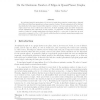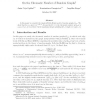592 search results - page 9 / 119 » Crossing numbers of random graphs |
FCT
2009
Springer
14 years 2 months ago
2009
Springer
We study the empire colouring problem (as defined by Percy Heawood in 1890) for maps whose dual planar graph is a tree, with empires formed by exactly r countries. We prove that, ...
JCT
2007
13 years 7 months ago
2007
A topological graph is quasi-planar, if it does not contain three pairwise crossing edges. Agarwal et al. [2] proved that these graphs have a linear number of edges. We give a sim...
STOC
2004
ACM
14 years 8 months ago
2004
ACM
Given d (0, ) let kd be the smallest integer k such that d < 2k log k. We prove that the chromatic number of a random graph G(n, d/n) is either kd or kd + 1 almost surely.
ICALP
2007
Springer
14 years 2 months ago
2007
Springer
In this paper we consider the classical Erd˝os-R´enyi model of random graphs Gn,p. We show that for p = p(n) ≤ n−3/4−δ , for any fixed δ > 0, the chromatic number χ...
APPROX
2004
Springer
14 years 1 months ago
2004
Springer
Given any integer d ≥ 3, let k be the smallest integer such that d < 2k log k. We prove that with high probability the chromatic number of a random d-regular graph is k, k + 1...


